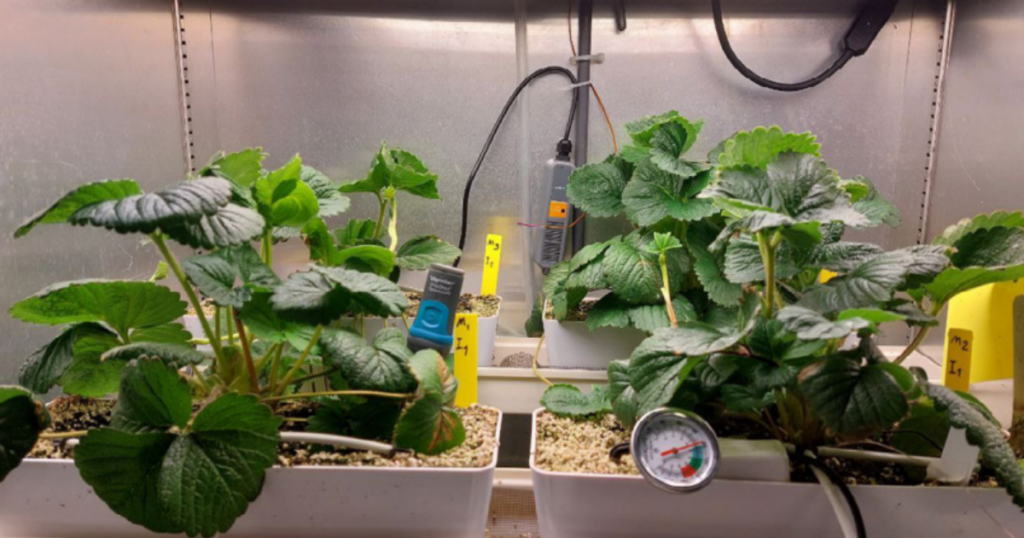Article and images by Moein Moosavi-Nezhad

chamber under LED lighting.
The farm gate value of the strawberry industry in the United States reached $2.3 billion in 2020. The predominant method of strawberry cultivation in the country involves annual plasticulture systems in which the growers across the US depend on obtaining new planting stock, sourced primarily from a select few strawberry nurseries in California, North Carolina, and Canada. These strawberry nurseries operate as specialized facilities, collectively generating over one billion plants each year within the United States. This production contributes significantly to the strawberry industry, augmenting the overall farm gate value by an estimated $200-300 million.
The common method of propagating strawberry plants in open-field nurseries poses challenges. This process involves multiple transfers of plant material between fields over several years before being sold for fruit production, leading to economic hardships for nursery operators and fruit producers in the US. Moreover, asymptomatic strawberry transplants can harbor harmful plant pathogens, causing disease outbreaks in production fields and resulting in significant nationwide production losses each year.
Runners in the farm nurseries grow horizontally, not only reducing plant density but also causing daughter plants (DPs) to come into contact with the soil surface, rendering them more susceptible to diseases. Additionally, the frequent need for manual removal of these runners increases labor requirements.
Based on discussions with nursery growers in California, they typically utilize a density of 12,000 to 13,000 plants per acre, equivalent to approximately 0.3 plants per square foot. This planting density results in an estimated yield of 300,000 to 400,000 DPs per acre over a production period of 180 days.
An alternative approach involves cultivating stock plants in controlled environments under artificial lighting where runners grow vertically hanging from the mother plants. Here, the plant density is usually higher (i.e., ~ 0.8 ft2), the DPs produced are typically disease-free, and there is reduced labor demand compared to traditional methods. However, due to the absence of natural light, a multitude of experiments is needed to optimize the lighting conditions, including intensity, photoperiod, spectrum, angle, and other relevant factors.
Ph.D. researcher Moein Moosavi-Nezhad has been conducting research on the cultivar Monterey since August 2022 at the Phytotron facility of NC State University. The research centers on cultivating strawberry stock plants for propagation, with a specific focus on studying the impacts of different photoperiods and plant densities.
Photoperiod
In the first experiment, Monterey strawberry tray plants (initial crown diameter = 12.2 ± 2.3 mm) were planted in 1.8 L pots with a plant density of 0.8 plants. ft-2. The photoperiod was set to 12, 16, and 20 h provided by white LED lights with the same daily light integral (DLI) of 26 mol day-1. Temperature, relative humidity, and CO2 were set to 26 °C, 60 %, and 400 µmol mol-1, respectively, with data logged every five minutes to ensure consistency across treatments. Following 64 days of growth under these conditions, DPs and runners were harvested, and yield and morphological parameters were recorded. With the same input of light (i.e., same DLI), both the number of DPs and stolons increased by 18 and 34.2 percent, respectively, only by lowering the duration of light (Figure 2). After a period of 64 days, Monterey stock plants grown under the 12-hour photoperiod produced more than 44 DPs and eight stolons.

